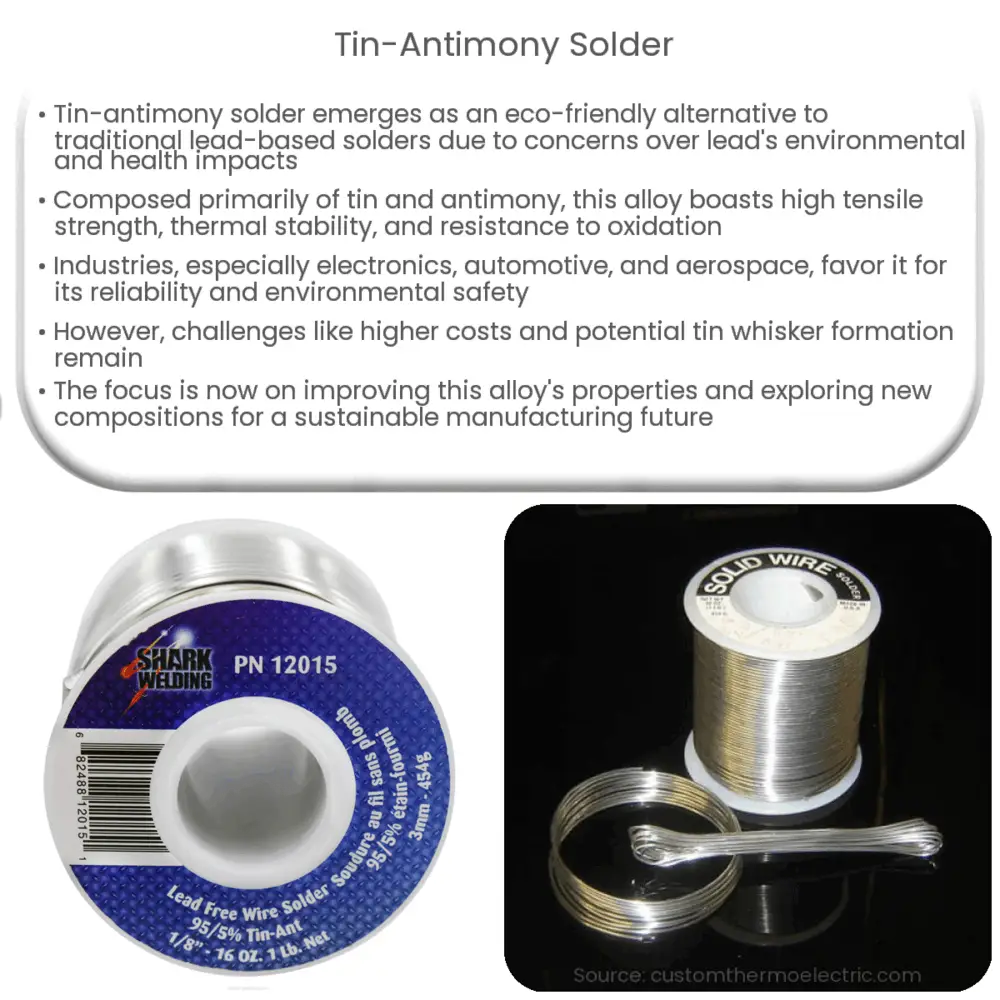Tin-antimony solder is an eco-friendly, lead-free alternative for electronics, offering high-performance, regulatory compliance, and environmental safety.

Tin-Antimony Solder: An Eco-friendly Alternative to Traditional Soldering Alloys
Introduction
Soldering is an essential process in the electronics industry, responsible for creating strong, electrically conductive bonds between various components. For many years, traditional lead-based solders have been the go-to choice for manufacturers, owing to their low melting points, ease of use, and cost-effectiveness. However, increasing concerns regarding the harmful effects of lead on human health and the environment have led to the development and adoption of alternative, eco-friendly soldering materials. One such alternative is the tin-antimony solder, which offers an attractive combination of performance and environmental safety.
Composition and Properties
Tin-antimony solder is an alloy composed primarily of tin (Sn) and antimony (Sb), with the latter typically constituting between 3 and 5 percent of the mixture. This alloy is characterized by its high tensile strength, impressive thermal stability, and excellent resistance to oxidation and corrosion. Additionally, it possesses a relatively low melting point, ranging from 230 to 240 degrees Celsius, which is comparable to that of traditional tin-lead solders.
Notably, the tin-antimony alloy is lead-free, making it a more environmentally friendly choice compared to its lead-based counterparts. In addition, it does not contain any other hazardous substances, such as cadmium or mercury, which are sometimes found in alternative soldering materials.
Applications and Advantages
Tin-antimony solder has found widespread use in various industries due to its desirable properties and compatibility with modern manufacturing processes. It is particularly well-suited for applications in the electronics, automotive, and aerospace sectors, where reliable, high-performance solder joints are critical for component longevity and overall system performance.
Some key advantages of tin-antimony solder include:
- Environmental Safety: As a lead-free alternative, tin-antimony solder reduces the risk of lead contamination in soil, water, and air, contributing to a cleaner and healthier environment.
- Regulatory Compliance: With the increasing number of regulations surrounding the use of hazardous materials, adopting tin-antimony solder helps manufacturers comply with legal requirements, such as the European Union’s Restriction of Hazardous Substances (RoHS) directive.
- Performance and Reliability: Tin-antimony solder provides excellent electrical conductivity, thermal stability, and resistance to mechanical stress, making it a reliable option for high-performance applications.
Challenges and Limitations
Despite its numerous advantages, tin-antimony solder does have some challenges and limitations that need to be considered by manufacturers. Some of the key concerns include:
- Cost: Tin-antimony solder can be more expensive than traditional lead-based solders, primarily due to the higher cost of antimony. This may be a factor for manufacturers looking to minimize production costs.
- Tin Whisker Formation: Tin-based solders, including tin-antimony, are more susceptible to the growth of tin whiskers, which are hair-like protrusions that can lead to electrical shorts and failures. Proper handling, storage, and manufacturing techniques can help mitigate this risk.
- Compatibility: Some electronic assemblies and components may not be compatible with tin-antimony solder, requiring manufacturers to make adjustments to their production processes or use alternative materials.
Conclusion
Tin-antimony solder offers a compelling alternative to traditional lead-based solders, with its combination of environmental safety, regulatory compliance, and high-performance characteristics. While it does present certain challenges and limitations, many industries have successfully adopted this alloy for their soldering needs, helping to reduce the harmful impact of lead on the environment and human health. As regulations surrounding the use of hazardous materials continue to evolve, tin-antimony solder is poised to become an increasingly important material in the electronics, automotive, and aerospace sectors, among others.
Future Outlook
As the demand for eco-friendly soldering materials continues to grow, research and development efforts are focusing on further improving the properties of tin-antimony solder and exploring new alloy compositions. These efforts aim to enhance the performance, reliability, and cost-effectiveness of lead-free solders, making them more attractive for manufacturers across various industries.
Ultimately, the widespread adoption of tin-antimony solder and other environmentally friendly alternatives is essential in reducing the harmful effects of traditional soldering materials on our planet. With continued innovation and the support of regulatory frameworks, tin-antimony solder is expected to play a significant role in creating a more sustainable and responsible electronics manufacturing landscape in the years to come.

